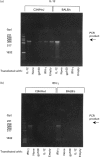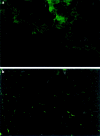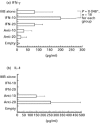Th1-biased immune responses induced by DNA-based immunizations are mediated via action on professional antigen-presenting cells to up-regulate IL-12 production
- PMID: 10606974
- PMCID: PMC1905537
- DOI: 10.1046/j.1365-2249.2000.01041.x
Th1-biased immune responses induced by DNA-based immunizations are mediated via action on professional antigen-presenting cells to up-regulate IL-12 production
Abstract
The efficacy of DNA-based immunization in conferring protective immunity against certain microbial pathogens including human immunodeficiency virus type 1 (HIV-1) has been described. The potential advantage of DNA-based immunization over the traditional vaccines largely results from its capacity to efficiently induce Th1-biased immune responses against an encoded antigen. We describe how Th1-biased immune responses are induced by DNA-based immunization, using a DNA vaccine construct encoding HIV-1 gp160 cDNA and an eukaryotic expression plasmid carrying murine IFN-gamma cDNA. Transfection of an eukaryotic expression plasmid carrying immunostimulatory sequences (ISS) as well as a gene of interest (DNA vaccine) into professional antigen presenting cells (APC) induced transactivation of IL-12 mRNA, which resulted in antigen-specific Th1-biased immune responses against the encoded antigen. Th1-biased immune responses induced by DNA-based immunization were substantially upregulated by a codelivery of an ectopic IFN-gamma expression system, and this augmentation was mediated via action on professional antigen presenting cells to upregulate IL-12 production. Taken together, it appears likely that Th1-biased immune responses induced by DNA-based immunization are mediated via action on professional antigen-presenting cells to produce IL-12. Interestingly, the model provided strikingly resembles that previously described in infection with Listeria monocytogenes, an intracellular Gram-positive bacterium that induces strong Th1-biased immune responses. The result suggests that DNA-based immunization mimics certain aspects of natural infection with microbial organisms like attenuated vaccines, which in turn provides a rationale to the question of why DNA-based immunization so efficiently induces protective immunity against these microbial pathogens.
Figures






Similar articles
-
Oral DNA vaccination promotes mucosal and systemic immune responses to HIV envelope glycoprotein.Virology. 2000 Feb 1;267(1):8-16. doi: 10.1006/viro.1999.0093. Virology. 2000. PMID: 10648178
-
Effects of antigen and genetic adjuvants on immune responses to human immunodeficiency virus DNA vaccines in mice.J Virol. 2002 Jan;76(1):243-50. doi: 10.1128/jvi.76.1.243-250.2002. J Virol. 2002. PMID: 11739689 Free PMC article.
-
Topical application of HIV DNA vaccine with cytokine-expression plasmids induces strong antigen-specific immune responses.Vaccine. 2001 Oct 12;20(1-2):42-8. doi: 10.1016/s0264-410x(01)00324-3. Vaccine. 2001. PMID: 11567744
-
Towards a new generation of vaccines: the cytokine IL-12 as an adjuvant to enhance cellular immune responses to pathogens during prime-booster vaccination regimens.Histol Histopathol. 2001 Apr;16(2):655-67. doi: 10.14670/HH-16.655. Histol Histopathol. 2001. PMID: 11332721 Review.
-
APC-targeted immunization for the treatment of HIV-1.Expert Rev Vaccines. 2004 Aug;3(4 Suppl):S189-98. doi: 10.1586/14760584.3.4.s189. Expert Rev Vaccines. 2004. PMID: 15285717 Review.
Cited by
-
PD1-based DNA vaccine amplifies HIV-1 GAG-specific CD8+ T cells in mice.J Clin Invest. 2013 Jun;123(6):2629-42. doi: 10.1172/JCI64704. Epub 2013 May 1. J Clin Invest. 2013. PMID: 23635778 Free PMC article.
-
Production and Immunogenicity of FeLV Gag-Based VLPs Exposing a Stabilized FeLV Envelope Glycoprotein.Viruses. 2024 Jun 19;16(6):987. doi: 10.3390/v16060987. Viruses. 2024. PMID: 38932278 Free PMC article.
-
The role of gamma interferon in DNA vaccine-induced tumor immunity targeting simian virus 40 large tumor antigen.Cancer Immunol Immunother. 2013 Feb;62(2):371-82. doi: 10.1007/s00262-012-1338-x. Epub 2012 Aug 25. Cancer Immunol Immunother. 2013. PMID: 22926061 Free PMC article.
-
DNA/MVA Vaccines for HIV/AIDS.Vaccines (Basel). 2014 Feb 28;2(1):160-78. doi: 10.3390/vaccines2010160. Vaccines (Basel). 2014. PMID: 26344473 Free PMC article. Review.
References
-
- Abbas AK, Murphy KM, Sher A. Functional diversity of helper T lymphocytes. Nature. 1996;383:787–93. - PubMed
-
- O'garra A. Cytokines induce the development of functionally heterogenous T helper cell subsets. Immunity. 1998;8:275–83. - PubMed
-
- Seder RA, Paul WE. Acquisition of lymphokine-producing phenotype by CD4+ T cells. Annu Rev Immunol. 1994;12:635–73. - PubMed
-
- Demant P, Lipoldova M, Svobodova M. Resistance to Leishmania major in mice. Science. 1996;274:1392. - PubMed
-
- Güler ML, Gorham JD, Hsieh C-S, Mackey AJ, Steen RG, Dietrich WF, Murphy KM. Genetic susceptibility to Leishmania: IL-12 responsiveness in TH1 cell development. Science. 1996;271:984–7. - PubMed
Publication types
MeSH terms
Substances
LinkOut - more resources
Full Text Sources
Other Literature Sources

